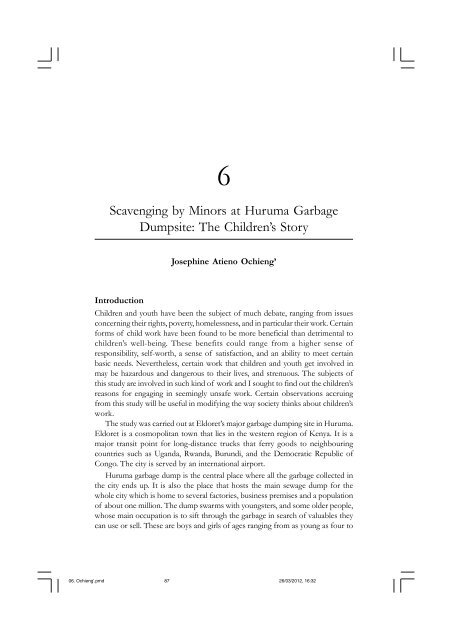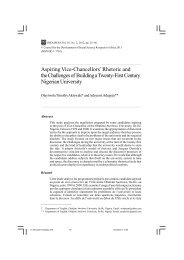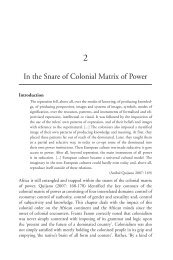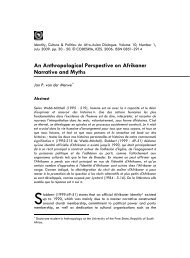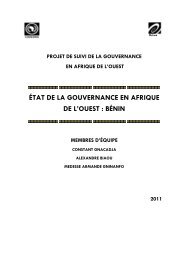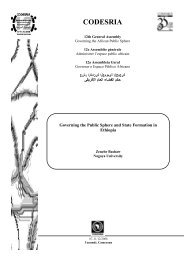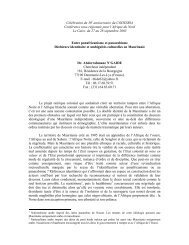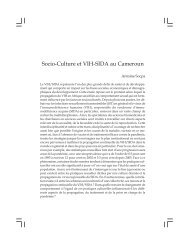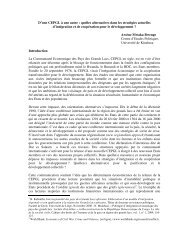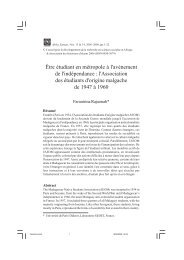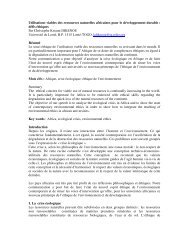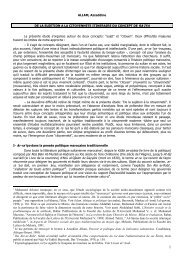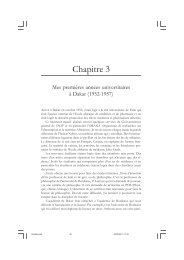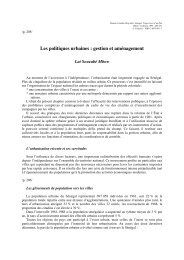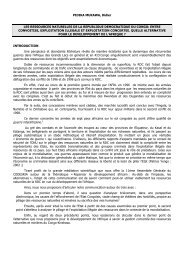06. Ochieng'.pmd - codesria
06. Ochieng'.pmd - codesria
06. Ochieng'.pmd - codesria
Create successful ePaper yourself
Turn your PDF publications into a flip-book with our unique Google optimized e-Paper software.
6<br />
Scavenging by Minors at Huruma Garbage<br />
Dumpsite: The Children’s Story<br />
Introduction<br />
Josephine Atieno Ochieng’<br />
Children and youth have been the subject of much debate, ranging from issues<br />
concerning their rights, poverty, homelessness, and in particular their work. Certain<br />
forms of child work have been found to be more beneficial than detrimental to<br />
children’s well-being. These benefits could range from a higher sense of<br />
responsibility, self-worth, a sense of satisfaction, and an ability to meet certain<br />
basic needs. Nevertheless, certain work that children and youth get involved in<br />
may be hazardous and dangerous to their lives, and strenuous. The subjects of<br />
this study are involved in such kind of work and I sought to find out the children’s<br />
reasons for engaging in seemingly unsafe work. Certain observations accruing<br />
from this study will be useful in modifying the way society thinks about children’s<br />
work.<br />
The study was carried out at Eldoret’s major garbage dumping site in Huruma.<br />
Eldoret is a cosmopolitan town that lies in the western region of Kenya. It is a<br />
major transit point for long-distance trucks that ferry goods to neighbouring<br />
countries such as Uganda, Rwanda, Burundi, and the Democratic Republic of<br />
Congo. The city is served by an international airport.<br />
Huruma garbage dump is the central place where all the garbage collected in<br />
the city ends up. It is also the place that hosts the main sewage dump for the<br />
whole city which is home to several factories, business premises and a population<br />
of about one million. The dump swarms with youngsters, and some older people,<br />
whose main occupation is to sift through the garbage in search of valuables they<br />
can use or sell. These are boys and girls of ages ranging from as young as four to<br />
<strong>06.</strong> <strong>Ochieng'</strong>.<strong>pmd</strong> 87<br />
26/03/2012, 16:32
88<br />
Negotiating the Livelihoods of Children and Youth in Africa’s Urban Spaces<br />
young adults of twenty-two. There are about forty to fifty youngsters at the site.<br />
These collectors use the water from the stream flowing near the dumping site to<br />
bathe in the open.<br />
Rationale<br />
Many African cities have seen an influx of large populations in search of livelihoods.<br />
The UN-Habitat’s then Executive Director, Dr. Anna Tibaijuka, on 30 June 2009<br />
told a conference on Peace, Justice, and Reconciliation in Africa that in 2008, the<br />
number of people living in urban areas exceeded those in rural areas, with Africa<br />
being the fastest urbanizing region. According to her, six out of ten urban residents<br />
in Africa are slum-dwellers, forced to live in deprivation with chronic lack of<br />
access to safe water, sanitation, sufficient housing, and security of tenure. The<br />
unfolding trend is referred to as ‘the urbanization of poverty’. Employment<br />
opportunities and livelihood options are few and far between.<br />
Children have also joined the older generation in this pattern of migration.<br />
However, they cannot get proper employment and have limited opportunities to<br />
create self-employment due to their limited education, experience, ability, and<br />
maturity. Consequently, they look for other means of survival, chief among them<br />
being street life, engagement in the informal labour sector, petty trade, begging,<br />
stealing, etc, in order to supplement family incomes. Some of the children have<br />
opted to go and live in major garbage dumping sites where they scavenge for<br />
discarded items for sale to be recycled or used for other purposes.<br />
There have been some studies on scavengers outside Africa. Barboza (2003)<br />
mentions minor scavenging activities in Nigeria, Brazil, Argentina, the Dominican<br />
Republic, and Cambodia. He describes children working barefoot and shirtless,<br />
and in circumstances where it is survival of the fittest, on dumpsites in Vietnam.<br />
The children had to make sure that they got to the dumpsite before the trucks<br />
started arriving. Some of the scavengers arrived as early as three o’clock in the<br />
morning and stayed until after seven in the evening. They foraged in the dump<br />
despite the extremely high temperatures. He mentions children as young as five<br />
racing after garbage trucks. Another study in Vietnam showed that children working<br />
all night on rubbish dumps were among the happiest, despite the dangers and<br />
dirt involved. They had good income, and worked within flexible hours among<br />
themselves. The children were as young as six and they worked without adult<br />
supervision (Theis 2001:103, cited in Bourdillon et al., 2010). Another study<br />
argued that children scavenging on rubbish heaps in the Philippines valued and<br />
enjoyed their work for its excitement and the companionship they found there,<br />
to the extent that it proved difficult to entice them to leave it (Gunn and Ostos,<br />
1992 cited in Bourdillon et al., 2010). As yet, there have been no major studies on<br />
child scavenging in Africa and this is a beginning.<br />
<strong>06.</strong> <strong>Ochieng'</strong>.<strong>pmd</strong> 88<br />
26/03/2012, 16:32
Ochieng’: Scavenging by Minors at Huruma Garbage Dumpsite 89<br />
The Huruma garbage dumping ground in Eldoret, Kenya, receives tens of<br />
truckloads of garbage of all kinds on a daily basis. The contents of these trucks<br />
include recyclable and unrecyclable items such as glass materials, plastics, paper,<br />
polythene, pieces of metal, boxes, and food items. The scavengers, who will<br />
sometimes be referred to as collectors, have cut out a niche for themselves at the<br />
dumpsite.<br />
The collectors are faced with several difficulties in their daily activities at the<br />
site. Eldoret is a high altitude area with extremely cold temperatures that can go<br />
as low as 12 degrees Celsius during the months of April through August, with the<br />
coldest being July. The children are also subjected to harassment from the residents<br />
of the neighbouring Huruma estate, especially if they stray into this neighbourhood.<br />
Yet, despite these squalid and harsh conditions, they continue working here –<br />
something that confounds observers who think it would be better for them to<br />
find more ‘decent’ livelihoods. Some have been said to run away from their<br />
homes, internally displaced persons’ camps, and even centres specifically set up<br />
for them to come and scavenge here.<br />
With the introduction of free primary education in the year 2003, it was<br />
expected that many out-of-school children – including those who were homeless<br />
– would go back to school. Indeed, in the first few years of implementing the<br />
policy, there was a reduction in the numbers of these children on streets in Kenyan<br />
towns as a result of frequent swoops conducted by law enforcement agencies.<br />
However, with time the enthusiasm of the enforcement authorities started waning,<br />
and many urban centres are now teeming with homeless and/or out-of-school children.<br />
I approached the subject of children’s work from their own point of view<br />
because of the emerging concern about the need to understand children in<br />
their own right. Ansell (2005:21) reiterates two important issues: first, that<br />
children should be studied independent of adult concerns; and second, that<br />
they are actually involved in constructing their own livelihoods. The ethnographic<br />
methods I employed allow children’s voices to be heard. There have been<br />
concerns that children’s voices are seldom heard, but that it is their photographs<br />
that are common (Ansell 2005:28). This chapter gives a voice to the children’s<br />
choice. At the same time, Woodhead (2007:34, 40) argues that children are social<br />
actors in the business of trying to make sense of their experiences, beginning at<br />
an early age to develop an appreciation of their and their families’ circumstances.<br />
He continues to state that consulting them is respectful of their participatory<br />
rights. Bourdillon (2004:101-102) reiterates the fact that most studies present only<br />
adult perspectives while paying very little attention to children’s views and agency<br />
in shaping their lives. He argues that scholars need to pay more attention to children’s<br />
potential and actual roles in development. Finally, it is mentioned by Rogers<br />
(2009:155-156) that when evaluating the quality of life, it is important to consider<br />
the views of those whose well-being is sought. Children are key stakeholders in<br />
<strong>06.</strong> <strong>Ochieng'</strong>.<strong>pmd</strong> 89<br />
26/03/2012, 16:32
90<br />
Negotiating the Livelihoods of Children and Youth in Africa’s Urban Spaces<br />
the services and care provided for them, and so their priorities and concerns are<br />
of paramount importance given that these may not necessarily be the same as<br />
those of their parents. I also intended to ascertain the role played by families in<br />
encouraging their children’s scavenger activities. While many families in Eldoret<br />
live in poverty, not all of them produce scavenger children. Thus the study aimed<br />
to shed light on the production of collectors.<br />
Methods Used<br />
There were three categories of respondents for this study. The main category<br />
was that of the collectors who worked at the Huruma dumping site. These were<br />
purposively sampled to enable more meaningful data collection, targeting those<br />
who had been at the site longest. I used three methods to collect data from the<br />
scavengers, namely, participant observation, intensive interviewing, and focus group<br />
discussions. I chose these three methods because they emphasized observations<br />
of natural behaviour and captured social life as it was experienced by the<br />
participants. These methods also allowed me to get a richer, more intimate view<br />
of the social world of the scavengers than I could have achieved using structured<br />
methods (Schutt 2006:320). During the interviews and group discussions, I used<br />
a guiding questionnaire. Data were collected over a period of two months.<br />
Partnerships were built by establishing rapport in the initial stages of contact.<br />
Rapport was useful in ensuring that the respondents spoke as honestly and as<br />
freely as possible. Catherine, my research assistant, and I first visited the site on a<br />
Sunday. We found several collectors idling about. Some of them were rummaging<br />
through the rubbish trying to find anything valuable. They became a little hostile<br />
to us and started asking which media house we were from. We told them that we<br />
were not news reporters and one of them informed us that, one time, a visitor<br />
came to the site and took a photograph of him. The next day, the photograph<br />
was published in a local newspaper and this caused some conflict with his family<br />
to whom he had not revealed that he was involved in scavenging. Catherine then<br />
told them that she worked at the local government hospital and, indeed, one of<br />
the collectors recognized her. He came over to us and reminded Catherine of<br />
their meeting at the hospital. She was also able to recall Maina and so our friendship<br />
with him began. He said that many of them had been cheated into believing that<br />
they were talking to donors who would bring them money; thus the hostility<br />
from the other collectors. We explained to him that we were on a research mission.<br />
He sent away the other scavengers and told them that we were his friends and<br />
that anyone who needed help at the hospital in future should not accost us. Maina<br />
then became our guide and informer and he provided us with much-needed<br />
protection. He took us round the approximately one-hectare dumpsite, showing<br />
us garbage in various stages of decomposition. Light and heavy clouds of smoke<br />
billowed from different sections of the garbage dump while a pack of swine<br />
<strong>06.</strong> <strong>Ochieng'</strong>.<strong>pmd</strong> 90<br />
26/03/2012, 16:32
Ochieng’: Scavenging by Minors at Huruma Garbage Dumpsite 91<br />
and goats rummaged through the heaps. Maina discreetly showed us his store, a<br />
place where he kept his collections. He then informed us that this day he was not<br />
dressed for work. On noticing our surprise, he offered to go and put on his<br />
work clothes. He disappeared into the bushes behind the dump and came back a<br />
few minutes later, dressed in the clothes. However, he told us that he could not<br />
show us his work tool, a metal prong with which he scratched through the garbage<br />
because the other collectors would see him retrieving it from its secret place. We<br />
spent around two hours at Huruma acquainting ourselves with the place and<br />
chatting with the few collectors who were present that day. Maina then said that<br />
it was getting late and that he wanted to go home to prepare for his favourite<br />
football show in the evening. He therefore took us on a brief tour of the slum<br />
area around the dumpsite and even showed us his house. His mother lived a few<br />
metres from there and he told us that she was not at home at that time, so there<br />
was no need to pass by her house. We agreed to meet the following Thursday to<br />
start our interviews with the other collectors, and he promised to convince his<br />
colleagues to cooperate with us.<br />
On the Thursday, I arrived at the Municipal Council Department at six o’clock<br />
in the morning. The Clerk-in-Charge assigned me a truck whose driver I shall<br />
henceforth refer to as Gilbert. Gilbert proved to be a very key informant for this<br />
study. As we rode around town loading the truck with garbage I noticed three<br />
collectors in the back. They assisted in loading the garbage onto it while they ran<br />
errands for the municipal loaders. They seemed to have good rapport with Gilbert<br />
and his colleagues and he informed me that they were scavengers whom he<br />
allowed to ride in the truck. These ‘privileged’ collectors started the process of<br />
scavenging for valuables in the truck before we got to Huruma. At one point,<br />
they showed me a half a sack of charcoal that they had found in the dustbin in<br />
one of the town restaurants. One of them, Tom, told me that this charcoal could<br />
fetch about sixty Kenya shillings (US$ 1 was at the time equivalent to approximately<br />
Ksh. 75). As the garbage heap grew in the truck, all the collectors and loaders in<br />
the back would alight and Gilbert would engage the compressor to push the<br />
garbage to the back to make space for more garbage to be loaded. When the<br />
truck was full, we headed for Huruma. As we neared the dumpsite, he stopped<br />
the truck and all the scavengers alighted with their collections for the day. Gilbert<br />
explained to me that the Huruma scavengers were not happy that he gave privilege<br />
to some collectors to start scavenging in the truck before arrival at the site. And as<br />
if in confirmation, during my interview that day with the collectors, some of<br />
them reported to me that Gilbert and his fellow drivers gave priority to other<br />
collectors from town and that, in fact, some of the valuables they collected were<br />
given to the municipal council workers. A twenty-year-old collector told me in<br />
no uncertain terms to tell Gilbert and his colleagues to stop subjecting them to<br />
unfair competition while they were in paid employment.<br />
<strong>06.</strong> <strong>Ochieng'</strong>.<strong>pmd</strong> 91<br />
26/03/2012, 16:32
92<br />
Negotiating the Livelihoods of Children and Youth in Africa’s Urban Spaces<br />
As soon as I alighted from the truck and tried to approach the collectors, the<br />
younger ones scurried off. Gilbert told me it was because they feared me. The<br />
older ones, on the other hand, were curious to know the purpose of my assignment.<br />
We told them that I was a teacher and that I had come to learn about their<br />
problems. They asked me to explain to them what I needed to know and how<br />
they would gain from my mission there. Gilbert helped me to organise them and<br />
to seek their permission to record our discussions. The children started opening<br />
up gradually and I realized that Maina had told them of my impending visit.<br />
During subsequent visits, I requested that we sit in a circle. The purpose of<br />
this sitting arrangement was to reduce the distance between us and to minimise<br />
any barriers that would interfere with the free flow of information. During the<br />
whole period that I visited Huruma, I dressed casually.<br />
Second, neighbourhood residents were conveniently drawn from the estate<br />
immediately surrounding the dumping site for discussion of their perceptions of<br />
the collectors’ activities. This depended on their availability, willingness, and ability<br />
to communicate in a common language. These included three government<br />
administrators (the chief of the location, the assistant chief, and the village elder),<br />
business owners and the residents. There was one group of five business owners<br />
and another group of seven residents. I did not put them together in one group<br />
because I wanted them to have uniformity of perspectives.<br />
Third, the municipal council workers who delivered garbage at the site everyday<br />
were interviewed on how they perceived child scavengers. All focus group<br />
discussions were carried out in unstructured interviews.<br />
We faced some challenges in carrying out this study. At first, the municipal<br />
authorities, especially some of the administrators, suspected that their work was<br />
under investigation. I had to explain to them the exact nature of the study and<br />
how the information would be used. When I first went to them, they said I was<br />
not authorized to ride in their trucks. Second, they were worried that I was going<br />
to report any anomalies I would notice at the department. When I gave them a<br />
letter of introduction from my employing organization, the Clerk-in-Charge agreed<br />
that I could go along in one of the trucks. However, some of the staff were still<br />
reluctant to have me around them as they went about their work. For instance,<br />
the driver of the first truck I boarded seemed uncomfortable with me. I had<br />
been assigned this truck and I got onto it but as soon as the driver arrived, he<br />
grew cold feet. He put me through a ‘grilling’ session on what my agenda was<br />
with collectors. He pointed out that he feared liability in case I got injured by the<br />
scavengers when we got to Huruma. The loader riding with him reiterated that<br />
the scavengers were quite unruly and that they could even snatch my camera. I<br />
therefore alighted and waited for ten minutes until Gilbert came in ‘his’ truck.<br />
<strong>06.</strong> <strong>Ochieng'</strong>.<strong>pmd</strong> 92<br />
26/03/2012, 16:32
Ochieng’: Scavenging by Minors at Huruma Garbage Dumpsite 93<br />
It is an important aspect in every research study to explain to participants what<br />
the information sought from them will be used for. This became apparent when<br />
the Municipal Council workers wanted an explanation of why I was interested in<br />
garbage collectors. To them, scavengers were not important people in society<br />
and I realized that there was a need for public sensitization. A common name<br />
given to scavengers in Eldoret is chokora, a derogatory term which, according to<br />
Davies (2008:314), denotes homeless children who do not attend school, and<br />
who only beg, steal, sniff glue, work for their food, and are always dirty and<br />
unclean.<br />
Some of the Municipal Council workers I interviewed also requested to have<br />
a copy of the tape I used in recording our discussion made available to them. I<br />
therefore had to incur extra costs to facilitate this.<br />
The collectors were in the business of making a living and so my data collection<br />
was an intrusion into their programme. In fact, on the day I was with Gilbert,<br />
most of the collectors participated in the interview while scratching through the<br />
garbage. Nonetheless, this had the benefit of yielding more accurate information<br />
as naturally as possible. I even spotted Maina and I asked him whether he<br />
remembered me. He responded in the affirmative but he seemed quite absorbed<br />
in his work. Some of the collectors expected hand-outs from me for accepting<br />
to suspend their work in order to give me attention. Others were suspicious of<br />
my intentions especially during initial contact. This was especially so with the younger<br />
children at the site. However, being a helping professional, I was able to find<br />
ways to go about it. This is described in the next section.<br />
Fig. 1. Collectors busy at work at Huruma<br />
<strong>06.</strong> <strong>Ochieng'</strong>.<strong>pmd</strong> 93<br />
26/03/2012, 16:32
94<br />
The Children<br />
Negotiating the Livelihoods of Children and Youth in Africa’s Urban Spaces<br />
The majority of the collectors came from low socio-economic backgrounds as<br />
they indicated that they lived in the slum area just next to the dumpsite. Many of<br />
them came from broken homes while some of them were orphaned. During the<br />
interviews, it emerged that many that many of them lacked food and proper<br />
shelter while others faced abuse and neglect. One of the respondents, Kimaru,<br />
said that his father had abandoned his mother before he was born and that his<br />
mother had died soon after his birth, leaving him in the care his grandmother,<br />
who also died when he was only five. He was eighteen at the time of the interview<br />
and had been at various dumpsites for close to twelve years. According to the<br />
others, Kimaru had been at the site longest.<br />
Those whose families were intact complained of idleness and need for money<br />
and food. They said that most of them attended school during business hours<br />
and only came to the site in the afternoons. These children mostly comprised<br />
younger boys and girls who claimed that they were bored at home because their<br />
parents, especially their mothers, worked all day. Ennew (1996:207) agrees that in<br />
urban settings, working mothers of children in difficult circumstances lacked<br />
child care, a significant recipe for what she calls ‘streetism’. The collectors also<br />
supposed that they did not get enough food at home and that the dumpsite<br />
provided an alternative source of food. This is alluded to by Evans (2004:70)<br />
who states that children encountered a ‘greater variety of food to be gained from<br />
the street’. According to Ansell (2005:47), many poor families were becoming<br />
increasingly unable to secure adequate food and their children were vulnerable to<br />
inadequate diets. One respondent showed me a polythene bag in which he had<br />
put all kinds of food items picked from the site. He said that younger ones<br />
fought for food with swine. The foodstuffs included ugali (a local staple made<br />
from maize flour), pieces of beef and chicken bones, bread, rice and chapati (a<br />
local delicacy made from wheat flour), decaying fruits such as mangoes, oranges,<br />
bananas, and lots of tomatoes. From interviews with Gilbert, such foodstuffs<br />
were often collected from restaurants while the fruits were found in the municipal<br />
market. For the children, this provided a balanced diet comprising starch, protein,<br />
and vitamins.<br />
The collectors had very low levels of education with the most highly educated<br />
having dropped out at standard five (in Kenya, children join primary school in<br />
standard one at around age six, and complete their primary education in standard<br />
eight). There were three categories of collectors: those who were engaged at<br />
Huruma full-time, those who came in the afternoons after school, and those who<br />
came to do some collecting during the school holidays only. Most of those who<br />
did not attend school indicated that despite the promises of free primary education,<br />
they still needed money to buy school uniforms, food, and other necessities.<br />
Ansell (2005:47) asserts that one reason children drop out of school is to be able<br />
<strong>06.</strong> <strong>Ochieng'</strong>.<strong>pmd</strong> 94<br />
26/03/2012, 16:32
Ochieng’: Scavenging by Minors at Huruma Garbage Dumpsite 95<br />
to contribute to household survival; while Bourdillon (2009:23-24) argues that<br />
schools in Africa may sometimes be unwelcoming, demeaning and grim, and<br />
may lack essential resources such as books, desks and even classrooms. One boy,<br />
Kodwaran, who had run away from home, reported that his father was too<br />
harsh and that he gave Kodwaran too much work to do. He also said that his<br />
father used to force him to go school yet he felt too old for that.<br />
Seemingly, with no proper source of income, some of these children were<br />
unable to meet their needs. To them, as indicated by Abraham Maslow in his<br />
hierarchy of needs, physiological needs such as food and clothing were more<br />
important than education. With low levels of education, most of the collectors<br />
could not find meaningful occupations in town because most of their competitors<br />
were better educated and consequently preferred by employers. Many of the<br />
collectors could barely write their names. Because most of the scavengers came<br />
from poor families, where other members most likely had minimal schooling,<br />
the parents might have been oblivious or even indifferent to the engagements of<br />
their children. Alternatively, because of their low levels of education and consequent<br />
low income, the parents allowed their children to work at Huruma provided they<br />
brought home some money. Indeed, as Lopez-Calva (2002) points out, the<br />
poverty status of the household and the education of the household head are the<br />
most robust determinants of child labour. According to him, under certain<br />
circumstances, a parent would rather send a child to work instead of sending him<br />
or her to school. However, this should not be used to conclude that parents are<br />
not altruistic toward their children.<br />
Many of those interviewed had running themes of broken homes and femaleheaded<br />
households. Most of them talked of having only a mother or no parent<br />
at all; but hardly any of them mentioned a father. In fact, fifteen out of twentythree<br />
said they did not know about their fathers. Evans (2004:80) notes one positive<br />
aspect of female-headed households as the greater freedom to engage in paid<br />
work. On the other hand, these households may face greater difficulties in gaining<br />
access to labour markets, credit, housing, and basic services. She enumerates parttime,<br />
informal jobs with low earnings, which are favoured by these females as<br />
beer-brewing, gardening, poultry-keeping, pig-keeping, and petty trading in<br />
foodstuffs and charcoal. These households are thus more vulnerable to<br />
impoverishment and insecurity, with negative consequences for the children.<br />
However, one of the collectors, James, said that he did not know about his<br />
father but later, a key informant confided that James actually had a responsible<br />
businessman father. According to the informant, James had decided to rebel<br />
against his father because he was unhappy with the latter’s choice of James’ brother<br />
as overseer of his transport truck. When I confronted James another day about<br />
this, he just laughed it off and said it was not true. However, the manner in which<br />
he said it, with a naughty smile on his face, was not convincing.<br />
<strong>06.</strong> <strong>Ochieng'</strong>.<strong>pmd</strong> 95<br />
26/03/2012, 16:32
96<br />
Negotiating the Livelihoods of Children and Youth in Africa’s Urban Spaces<br />
Some of the collectors lived alone in rented rooms while others lived with<br />
their families; but all of them lived in the slum area next to the dumpsite. Most of<br />
the housing there was temporary, with cracked mud walls and iron sheets and<br />
only large enough for a bed and a kitchen area. The windows and doors were<br />
made of wood. Many of the collectors without families shared these rooms.<br />
Some of them such as Kevin did not have rooms of their own. Kevin mostly<br />
engaged in scavenging for foodstuffs which he sold to swine breeders at thirty<br />
Kenyan shillings per sack. He then paid twenty shillings to someone for<br />
accommodation each night. He fed on the pig food he collected. Kevin did not<br />
know his parents and he scavenged along with his twin brother who was not at<br />
the site the days I visited. The participants informed me that he was not mentally<br />
alright and that was why he did not even own a prong with which to scratch.<br />
When I asked him about using his bare hands in the garbage, he did bother to<br />
respond and instead asked me for money to buy lunch.<br />
From the children’s point of view, they engaged in collecting due to several<br />
factors including helplessness, the need to fill their leisure time, irresponsible<br />
parenthood, frustration, poverty, and general family dysfunction. Thus, as has<br />
been discussed, the dumpsite provided a sure and precise way to get around their<br />
situation while it helped to fill the gaps in their lives.<br />
The Children’s Work<br />
The collectors arrive at the site in the morning hours to await the delivery trucks.<br />
As a truck approaches, they all follow it to be in the best position to start sifting<br />
through the garbage.<br />
Many of the collectors did not like what they did, but said that there was no<br />
other way for them to get money. Others did not mind the work provided it<br />
brought them money. One of the collectors, Peter, was concerned that some of<br />
the garbage came with used syringes and needles which as stated by him, posed a<br />
threat to the younger children in this era of HIV. One thing that these children<br />
enjoyed was the autonomy with which they engaged in their activities.<br />
Gilbert, Catherine, and the municipal council clerk all informed me that there<br />
was a destitute children’s home in the town where needy children could go to be<br />
taken care of. On broaching this subject with the collectors, they all responded<br />
negatively. This made me wonder about their unanimous response to the subject.<br />
Then one of them said that the conditions at the home were not conducive for<br />
them. He said, ‘How can I be told to cut grass around the compound before I<br />
am given food to eat? Even my late father did not ask me to do that when he was<br />
alive!’ On saying this, all the others burst into laughter.<br />
Seemingly, these children did not like to be told what to do or to be supervised<br />
as they worked. I had got to know that the local Department of Social Services<br />
provided food for needy children every day around lunchtime. On enquiring<br />
<strong>06.</strong> <strong>Ochieng'</strong>.<strong>pmd</strong> 96<br />
26/03/2012, 16:32
Ochieng’: Scavenging by Minors at Huruma Garbage Dumpsite 97<br />
about this too, all the participants chuckled. They said that walking to the social<br />
hall to get food was a waste of the time they would rather spend collecting<br />
valuables for sale. The collectors thus appeared to feel a sense of pride in being<br />
able to earn some money for food rather than to be provided with free handouts.<br />
This seemed good for their self-esteem and sense of self-worth and it may<br />
provide fertile ground for further research into children’s work.<br />
The conditions at the dumpsite are very hard on the children. As we approached<br />
the dumpsite in the truck, scores of children and youth started running after the<br />
truck(s) and directing the driver(s) as to the best location to empty the garbage.<br />
Some of them started pulling out items even before the trucks come to a complete<br />
stop. This struggle assures them of a vantage point from which to embark on<br />
their work. Each of the scavengers was armed with a metal prong with which he<br />
or she sifted through the ‘fresh’ garbage. And as if that was not difficult enough,<br />
a herd of swine joined in rummaging through the garbage. Consequently, the<br />
scavengers had to fight off the swine while, at the same time, making sure they<br />
continued searching.<br />
Ansell (2005:171) has supposed that opposition to children’s work has centred<br />
on the potential hazards it poses. He writes that children are more liable than<br />
adults to suffer occupational injuries due to inattention, fatigue, poor judgement,<br />
and insufficient knowledge. At Huruma, the competition for the garbage is so<br />
intense that the children sometimes throw caution to the wind in a bid to survive.<br />
One participant in the study showed me a large scar on his right thigh that has<br />
remained as a constant reminder of his difficult life. Julian was going about his<br />
collecting business as usual one day when a truckload of garbage arrived at the<br />
site. Together with his colleagues, he chased after it as usual. Julian decided to<br />
climb onto the moving truck but accidentally, he slipped and fell and the truck ran<br />
over his leg. He was seriously injured and after offloading the truck, the driver<br />
together with some of Gilbert’s friends took him to hospital. He remained there<br />
for close to three months and he had to undergo major reconstructive surgery.<br />
I was saddened by the account, yet Julian and his colleagues laughed as they<br />
narrated it to me. It seemed as if the ordeal was only a temporary setback as they<br />
stated that Julian was back at Huruma soon after his release from hospital. In fact,<br />
whenever he omitted any part of his narrative, his colleagues would gladly fill in the<br />
missing facts.<br />
Julian’s story made me wonder how the collectors managed to pay their medical<br />
bills. It was encouraging to hear that the local government hospital provided free<br />
medical care for them. However, they indicated that whenever they visited the<br />
hospital, they had to dress in a certain way in order to pass as needy citizens. This<br />
was a very good example of how these children manage to negotiate their<br />
livelihoods in difficult circumstances.<br />
<strong>06.</strong> <strong>Ochieng'</strong>.<strong>pmd</strong> 97<br />
26/03/2012, 16:32
98<br />
Negotiating the Livelihoods of Children and Youth in Africa’s Urban Spaces<br />
Along with these, other hardships included being roughed up by the municipal<br />
council guards, aggression from passers-by and estate residents, and harassment<br />
from the police and the public whenever a crime was committed in the<br />
neighbourhood. Despite all this, the collectors continued their businesses here<br />
with determination.<br />
The collectors indicated that most of them suffered respiratory-related<br />
complications and my research assistant confirmed this form her observation at<br />
the hospital. They told me that their work exposed them to risks of respiratory<br />
infections because of prolonged exposure to the smoke and stench at the dump.<br />
Gilbert told me that part of the garbage delivery teams’ work was to set the<br />
garbage on fire in order to create space for yet more garbage. A study at the<br />
Stung Meanchey Municipal Waste Dump in Cambodia found dangerously high<br />
levels of dioxin in the soil and large amounts of heavy metals in the metabolism<br />
of children working there. These children sought treatment for rashes, infections,<br />
cuts and bruises (Barboza 2003:A4). Other illnesses that the children suffered<br />
were related to the occasional low temperatures.<br />
Social Networks<br />
There were strong social networks and a sense of comradeship among the<br />
collectors, together with a feeling of responsibility for each other. This was attested<br />
to by most of the collector respondents who intimated that whenever any of<br />
them became too ill, it was the responsibility of the others to help him or her get<br />
to hospital and to ensure that they got treatment. Veale et al in Evans (2004:70)<br />
affirms that some of the gains of street-life were the development of strong<br />
friendships and the satisfaction of being able to manage their lives. Davies<br />
(2008:319) found out that, indeed, scavenging and eating leftovers united (both<br />
males and females) in a common bond; other children did not engage in such<br />
activities. Another social benefit of living off the dumpsite was that the collectors<br />
were well treated by the staff of the Moi Teaching and Referral Hospital where<br />
they received free medical treatment.<br />
As children approach adolescence, peer influence increases while parental<br />
influence diminishes (Myers 2008:121). This may help explain why the bond these<br />
children have developed at the garbage dumpsite is very strong. At Huruma, they<br />
can interact with peers, learn from them, and provide each other with a safe<br />
haven from which to explore. On the Sunday Catherine and I first visited the site,<br />
we found several collectors sitting around and chatting casually. One of them had<br />
a radio on which he was listening to music. This was an indication that they had a<br />
sense of belonging to the dumpsite and that they felt at home in Huruma. Thus,<br />
as every human being needs a sense of identity, so the collectors have found that<br />
identity at the dumpsite, thereby passing time even on days when trucks do not<br />
bring in any garbage. In fact, one study of street children who lived in a dirty<br />
<strong>06.</strong> <strong>Ochieng'</strong>.<strong>pmd</strong> 98<br />
26/03/2012, 16:32
Ochieng’: Scavenging by Minors at Huruma Garbage Dumpsite 99<br />
polluted territory with open sewers and mud in Makutano in Kenya, revealed<br />
that they were actually relaxed and that they played without the threat of harassment.<br />
They were powerful in this territory and were considered dangerous and<br />
threatening. The children paradoxically reinforced notions of pollution and danger<br />
to create a safe and empowering world around them, and this was referred to by<br />
Beazley as ‘winning of space’ (cited in Davies 2008:321).<br />
During the interviews, some of those who were not participating were busy<br />
playing after keeping their valuables in their ‘stores’. Each of the scavengers had a<br />
‘store’ that was well known and respected by others. On asking how safe their<br />
belongings were in the open ‘stores’, they told me that nobody dared touch<br />
another person’s belongings. I was impressed with this sense of morality and<br />
respect for each other’s rights. There was a high degree of organization at the<br />
dumpsite and the collectors seemed to have developed a sense of maturity not<br />
common among other children their age. As they played, I could perceive fairness,<br />
teamwork, and advocacy in their dealings; all these without any supervision from<br />
an adult. This concurred with Woodhead’s observation that one function of work<br />
was that it provided an opportunity for children to learn skills like responsibility,<br />
communication, and teamwork (Woodhead, 2007:41).<br />
The garbage site seemingly provided an escape from adverse conditions at<br />
home. According to Hungerland (2007:172), when children engage in activities<br />
that are unsupervised by adults and have their own money, it gives them a sense<br />
of autonomy they can scarcely find elsewhere.<br />
Earnings<br />
According to the children, they could not sell their wares directly in the market as<br />
they had no links with the recyclers. They depended on middlemen to buy the<br />
assorted items from them for onward sale to recycling plants. The collectors<br />
scavenged for assorted items such as tin, glass, plastic, paper, cloth, sacking, food,<br />
and many other valuables. They sold plastic for Ksh. 4 per kilogramme and<br />
paper for Ksh. 2. Pig food was sold to estate residents for Ksh. 30 per sack. On<br />
average, each scavenger made about Ksh. 100 a day, but this depended on how<br />
hard one worked and how keen one was in following the trucks. On a less<br />
fruitful day, each made only around fifty shillings. The scavengers complained<br />
that they were exploited by the middlemen who paid very little for the scavenged<br />
items. For instance, they (middlemen) sold a kilogramme of plastic for Ksh. 16,<br />
and sometimes even Ksh. 18, which was way above the buying price. I did not<br />
get a chance to verify this from the middlemen.<br />
So how did they spend the small amounts of money they earned? Some of<br />
the younger children said that their parents were aware of their coming to scavenge<br />
and that they even contributed to the upkeep of their families. Others said that<br />
they used the money for needs such as food, clothing, and to pay for video<br />
<strong>06.</strong> <strong>Ochieng'</strong>.<strong>pmd</strong> 99<br />
26/03/2012, 16:32
100<br />
Negotiating the Livelihoods of Children and Youth in Africa’s Urban Spaces<br />
shows including European football. Some of them complained that the money<br />
they earned was so little that they had to share accommodation to cut on costs.<br />
Those who came after attending school were mostly interested in foodstuffs.<br />
These were younger boys and girls who occasionally stumbled upon valuables<br />
such as tins or bottles which they exchanged with the older collectors already<br />
linked to middlemen. They in turn received favours in cash and/or kind – including<br />
protection from bullies – or for as little as two shillings. They were also too<br />
young to fight with the older ones for garbage and to negotiate fair prices for<br />
their goods.<br />
Views of Residents and Municipal Workers<br />
The views of neighbourhood residents differed sharply from those of the<br />
collectors. Residents were of the opinion that the garbage dump was a menace to<br />
them, given the stench that it produced during the rainy season. Second, according<br />
to them, it had led to cases of indiscipline among children who preferred to go<br />
and scavenge rather than stay at home to work. The dump made the children to<br />
want to get money at a tender age when they were supposed to concentrate on<br />
their childhood and education. Residents also insinuated that their own children<br />
liked to go and pick food items from the garbage. They thought that the dump<br />
attracted all kinds of children, some of whom were in the habit of stealing from<br />
them. They were concerned that whenever they reported these incidences to the<br />
police, they fell victim to acts of revenge. They were unhappy that the dump site<br />
exposed them such insecurity. As a result, they suggested that the site be relocated<br />
to another part of the municipality and that the government improves on its<br />
responsibility to protect its citizens. However, this would only be a relocation of<br />
the problem. It should be clear that the residents said nothing positive about the<br />
collector activities at Huruma. This is supported by Tagliaventi (2007:166) who<br />
confirms that children’s views of their work differ a great deal from those of adults.<br />
The municipal council workers were sympathetic to the collectors. As mentioned<br />
earlier, some of them allowed collectors to scavenge on the trucks. Their argument<br />
was that there was no point disposing of items that could be of use to collectors<br />
and that the garbage was a major source of livelihood for the children. They<br />
provided an example of a time when the municipal workers went on strike to<br />
protest against low salaries. The collectors held a demonstration in town demanding<br />
that the workers’ grievances be addressed so that they could return to work and<br />
restore their (scavengers) lifeline.<br />
On the issue of persistence of collectors, they suggested four main factors<br />
responsible for this problem. These included very large families, poverty, broken<br />
homes, and indiscipline in society. They thought that the public played a role in<br />
encouraging scavenging because they bought goods from collectors and also<br />
gave them handouts. Another point that emerged from my discussions with the<br />
<strong>06.</strong> <strong>Ochieng'</strong>.<strong>pmd</strong> 100<br />
26/03/2012, 16:32
Ochieng’: Scavenging by Minors at Huruma Garbage Dumpsite 101<br />
municipal workers was that the collectors did not like to take on paid employment<br />
and that they liked the ‘easy’ money they got after scavenging. They gave an example<br />
of a collector who got a job as a herd-boy, but failed to keep it and ran away<br />
after one week. In fact, Tagliaventi (2007:165) acknowledges the immediate and<br />
tangible satisfaction children derive from their work; and they are aware of<br />
discerning both its positive and negative aspects. The municipal workers explained<br />
that the collectors were uncomfortable with a programmed life such as is found<br />
in needy children’s homes probably because of the discipline involved. They<br />
indicated that the majority of those who were taken to these centres later ran<br />
away. Hungerland (2007:171) suggests that children find tasks assigned them by<br />
parents [and other adults] undesirable, natural, unpleasant and boring. One<br />
important finding though, was that most of the adult respondents believed that<br />
irresponsible parenthood was the main cause of minor scavenging. They supposed<br />
that most of the children at the site came from broken or unstable homes that<br />
were mostly female-headed. This fact was confirmed in the discussions with the<br />
children themselves. As Evans (2004:86) notes, increasing numbers of children<br />
from households that had dispersed are turning to the informal sector to support<br />
themselves as families and communities are unable or unwilling to support them.<br />
Conclusion<br />
This chapter is partly a revelation of the value of children’s work. Children use<br />
work to fill up their free time while they contribute to their upkeep. Not all<br />
children place a high premium on education, perhaps because the dividends are<br />
not readily realised. Children’s work is not all negative as it may help them to<br />
develop a sense of responsibility and maturity in them. It also assists children’s<br />
sense of autonomy while providing a positive way of avoiding ‘adult domination’.<br />
This therefore should provoke society to rethink their attitudes about children’s<br />
autonomy and independence. Invernizzi (2007:141) avers that when work allows<br />
greater control over the environment, the result is self-esteem and confidence.<br />
Children are creative beings with a certain capacity to negotiate their livelihoods.<br />
They are not merely empty vessels waiting to be filled with adult ideas. They<br />
should be given an ear; their opinions ought to be valued and incorporated in<br />
programmes targeting them.<br />
Nevertheless, a certain degree of adult responsibility is still wanting. For instance,<br />
society should be ready to protect children in whatever they choose to engage in.<br />
This is in relation to providing and facilitating a safe environment for all children’s<br />
activities. In the case of Huruma, for instance, medical and other establishments<br />
should be responsible enough to follow safety precautions especially when<br />
discarding used apparatus. The government should ensure that children and minors<br />
are not exploited nor taken advantage of. All members of society need to respect<br />
children’s rights. They should provide good role models for all children.<br />
<strong>06.</strong> <strong>Ochieng'</strong>.<strong>pmd</strong> 101<br />
26/03/2012, 16:32
102<br />
Negotiating the Livelihoods of Children and Youth in Africa’s Urban Spaces<br />
From this study, I found out that most children enjoyed what they did in<br />
terms of work. The connotation of child labour may not be so for the children<br />
themselves. This is because children’s work may provide a safety valve for pentup<br />
struggles, frustrations, and emotions. According to the frustration-aggression<br />
principle, an individual’s frustration can generate aggression when they do not get<br />
a safety valve for venting the negative energies that may result (Myers, 2008:553).<br />
They may therefore turn to destructive behaviours such as delinquency and violence.<br />
The minor scavengers at Huruma faced several challenges in their lives, and despite<br />
the frustrations they may have faced, they decided to channel their energies into a<br />
relatively positive pursuit. This pursuit was helpful to society in the recycling process<br />
and in the prevention of delinquent behaviour.<br />
An important suggestion is that children who are involved in the informal<br />
labour sector could be provided with formal schooling outside their working<br />
hours. They could also be registered by the government so that they get protection<br />
and be provided with care where need be. The psychological benefits of paid<br />
work for these children could be investigated. Ways of making the work safer<br />
for them should be explored since working in the garbage dumps is hazardous<br />
in nature.<br />
References<br />
Ansell, Nicola, 2005, Children, Youth and Development, New York: Routledge/Taylor & Francis<br />
Group.<br />
Barboza, David, 2003, ‘Children Scavenge a Life, of Sorts, in the Garbage’, Phnom Penh<br />
Journal. Reproduced by the New York Times, available at www.nytimes.com. Accessed 20<br />
January 2010.<br />
Bourdillon, Michael, 2004, ‘Children in Development’, Progress in Development Studies, Vol 4,<br />
No.2, pp. 99-113.<br />
Bourdillon, Michael, 2009, ‘Children’s Work in Southern Africa’, Werkwinkel, Vol 4, No.1,<br />
pp. 103-122.<br />
Bourdillon, M., Levison, D., Myers, W., and White, B., 2010, Rights and Wrongs of Children's<br />
Work, New Brunswick, etc.: Rutgers University Press.<br />
Davies, Matthew, 2008, ‘A Childish Culture? Shared Understandings, Agency and<br />
Intervention: An Anthropological Study of Street Children in Northwest Kenya’,<br />
Childhood: A Journal of Global Child Research, Vol. 15, No.3, pp. 309-330.<br />
Ennew, Judith, 1996, ‘Difficult Circumstances: Some Reflections on "Street Children" in<br />
Africa’, Africa Insight, Vol. 26, No.3, pp. 203-210.<br />
Evans, Ruth M.C., 2004, ‘Tanzanian Childhoods: Street Children’s Narratives of "Home"’,<br />
Journal of Contemporary African Studies, Vol. 22, No. 1, pp.69-92.<br />
Gunn, S.E. and Ostos, Z., 1992, ‘Dilemmas in Tackling Child Labour: The Case of Scavenger<br />
Children in the Philippines’, International Labour Review, Vol.131, pp.629-646.<br />
Hungerland, Beatrice, 2007, ‘Work - A Way to Participative Autonomy for Children’, in B.<br />
Hungerland, M. Liebel, B. Milne, and A. Wihstutz, eds, Working to Be Someone. Child<br />
Focused Research and Practice with Working Children, London: Jessica Kingsley, pp.167-175.<br />
<strong>06.</strong> <strong>Ochieng'</strong>.<strong>pmd</strong> 102<br />
26/03/2012, 16:32
Ochieng’: Scavenging by Minors at Huruma Garbage Dumpsite 103<br />
Invernizzi, Antonella, 2007, ‘Children’s Work as "Participation": Thoughts on Ethnographic<br />
Data in Lima and the Algarve’, in B. Hungerland, M. Liebel, B. Milne, and A. Wihstutz,<br />
eds, Working to Be Someone: Child Focused Research and Practice with Working Children, London:<br />
Jessica Kingsley. pp. 135-144.<br />
Lopez-Calva, Luis F., 2001, ‘Child Labor: Myths, Theories and Facts’, Journal of International<br />
Affairs, Vol. 55, No.1. Available at www.questia.com.<br />
Myers, David G., 2008, Exploring Psychology, 7 th Ed, New York: Worth Publishers.<br />
Rogers, Wendy Stainton, 2009, ‘Promoting Better Childhoods. Constructions of Child<br />
Concern’, in M. J. Kehily, ed., An Introduction to Childhood Studies, 2 nd Edition, Berkshire:<br />
Open University Press, pp.141-160.<br />
Schutt, Russell K, 2006, Investigating the Social World. The Process and Practice of Research, 5 th<br />
Edition, Thousand Oaks: SAGE Publications.<br />
Tagliaventi, MariaTeresa, 2007, ‘Child Work and Child Labour in Italy: The Point of View of<br />
the Children’, in B. Hungerland, M. Liebel, B. Milne, and A. Wihstutz, eds., Working to<br />
Be Someone: Child Focused Research and Practice with Working Children, London: Jessica<br />
Kingsley, pp.161-166.<br />
Theis, Joachim, 2001, ‘Participatory Research with Children in Vietnam,’ in Schwartzman,<br />
H. B., ed., Children and Anthropology: Perspectives for the 21 st Century, London, etc.: Bergin<br />
and Garvey, pp.99-109.<br />
Tibaijuka, Anna, 2009, Keynote Address for the Association of Catholic Universities and<br />
Higher Institutes in Africa and Madagascar Conference on Justice and Peace at the Catholic<br />
University of Eastern Africa, Nairobi, 30 June 2009.<br />
Woodhead, Martin, 2007, ‘Harmed by Work or Developing Through Work?: Issues in the<br />
Study of Psychosocial Impacts’, in B. Hungerland, M. Liebel, B. Milne, and A. Wihstutz,<br />
eds, Working to Be Someone: Child Focused Research and Practice with Working Children, London:<br />
Jessica Kingsley, pp. 31-42.<br />
<strong>06.</strong> <strong>Ochieng'</strong>.<strong>pmd</strong> 103<br />
26/03/2012, 16:32
<strong>06.</strong> <strong>Ochieng'</strong>.<strong>pmd</strong> 104<br />
26/03/2012, 16:32


